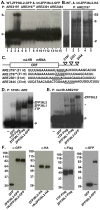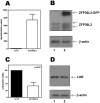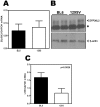The RNA-binding protein, ZFP36L2, influences ovulation and oocyte maturation
- PMID: 24830504
- PMCID: PMC4022657
- DOI: 10.1371/journal.pone.0097324
The RNA-binding protein, ZFP36L2, influences ovulation and oocyte maturation
Abstract
ZFP36L2 protein destabilizes AU-rich element-containing transcripts and has been implicated in female fertility. In the C57BL/6NTac mouse, a mutation in Zfp36l2 that results in the decreased expression of a form of ZFP36L2 in which the 29 N-terminal amino acid residues have been deleted, ΔN-ZFP36L2, leads to fertilized eggs that arrest at the two-cell stage. Interestingly, homozygous ΔN-Zfp36l2 females in the C57BL/6NTac strain release 40% fewer eggs than the WT littermates (Ramos et al., 2004), suggesting an additional defect in ovulation and/or oocyte maturation. Curiously, the same ΔN-Zfp36l2 mutation into the SV129 strain resulted in anovulation, prompting us to investigate a potential problem in ovulation and oocyte maturation. Remarkably, only 20% of ΔN-Zfp36l2 oocytes in the 129S6/SvEvTac strain matured ex vivo, suggesting a defect on the oocyte meiotic maturation process. Treatment of ΔN-Zfp36l2 oocytes with a PKA inhibitor partially rescued the meiotic arrested oocytes. Furthermore, cAMP levels were increased in ΔN-Zfp36l2 oocytes, linking the cAMP/PKA pathway and ΔN-Zfp36l2 with meiotic arrest. Since ovulation and oocyte maturation are both triggered by LHR signaling, the downstream pathway was investigated. Adenylyl cyclase activity was increased in ΔN-Zfp36l2 ovaries only upon LH stimulation. Moreover, we discovered that ZFP36L2 interacts with the 3'UTR of LHR mRNA and that decreased expression levels of Zfp36l2 correlates with higher levels of LHR mRNA in synchronized ovaries. Furthermore, overexpression of ZFP36L2 decreases the endogenous expression of LHR mRNA in a cell line. Therefore, we propose that lack of the physiological down regulation of LHR mRNA levels by ZFP36L2 in the ovaries is associated with anovulation and oocyte meiotic arrest.
Conflict of interest statement
Figures







References
-
- Practice Committee of the American Society for Reproductive M (2006) Definition of "infertility". Fertil Steril 86: S228. - PubMed
-
- Zegers-Hochschild F, Adamson GD, de Mouzon J, Ishihara O, Mansour R, et al. (2009) The International Committee for Monitoring Assisted Reproductive Technology (ICMART) and the World Health Organization (WHO) Revised Glossary on ART Terminology. Hum Reprod 24: 2683–2687. - PubMed
-
- Zegers-Hochschild F, J.E S (2008) In: Heggenhougen K, Quah SR, editors. International encyclopedia of public health. Oxford: Academic. pp. 576–587.
-
- Lai WS, Carballo E, Thorn JM, Kennington EA, Blackshear PJ (2000) Interactions of CCCH zinc finger proteins with mRNA. Binding of tristetraprolin-related zinc finger proteins to Au-rich elements and destabilization of mRNA. J Biol Chem 275: 17827–17837. - PubMed
Publication types
MeSH terms
Substances
Grants and funding
LinkOut - more resources
Full Text Sources
Other Literature Sources
Molecular Biology Databases
Miscellaneous

